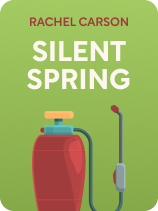

This article is an excerpt from the Shortform book guide to "Silent Spring" by Rachel Carson. Shortform has the world's best summaries and analyses of books you should be reading.
Like this article? Sign up for a free trial here.
What are the most insightful Silent Spring quotes about pest control? Do pesticides pose a threat to humanity?
In Silent Spring, biologist Rachel Carson condemns the widespread use of pesticides in the 20th century, arguing that these chemicals threaten to devastate the natural environment and poison animals and humans alike. Carson advocates stricter regulation of pesticides by the US government, limited spraying, and the use of biological controls.
Below we’ve provided a few Silent Spring quotes for better context.
Quotes From Silent Spring
In Silent Spring, biologist Rachel Carson condemns the widespread use of pesticides in the 20th century, arguing that these chemicals threaten to devastate the natural environment and poison animals and humans alike. Carson advocates stricter regulation of pesticides by the US government, limited spraying, and the use of biological (rather than chemical) controls. Though Carson’s book was controversial and widely condemned by chemical companies, it’s been credited as an inspiration for the environmentalist movement of the 1970s, the formation of the US Environmental Protection Agency, and the banning of the pesticide DDT.
Take a look at these Silent Spring quotes to get the full scope of Carson’s argument.
“A Who’s Who of pesticides is therefore of concern to us all. If we are going to live so intimately with these chemicals eating and drinking them, taking them into the very marrow of our bones – we had better know something about their nature and their power.”
An effect of spraying that’s not immediately obvious is pesticides’ ability to sterilize or greatly reduce a species’ capacity to reproduce. Birds and fish sprayed with pesticides either fail to lay eggs, or those eggs never develop. Livestock like pigs, cows, or sheep carry fewer babies to term, and those that are born are often sickly and die young. Carson notes that testing of the bodies and the undeveloped eggs has shown that they contain large quantities of chemicals like aldrin and dieldrin. Ultimately, even animals that survive spraying will struggle to build their populations up to former levels and may die out entirely in a few generations. It’s not clear whether pesticides can also impair humans’ ability to reproduce.
Carson believes that these reproductive issues are linked to pesticides’ ability to damage species’ DNA by interrupting cellular division (the process by which cells reproduce) and cellular oxidation (the process by which cells produce energy). Some cells die off, while others produce dangerous mutations in new cells. For example, plants sprayed with lindane produced offspring containing extra chromosomes in their DNA, resulting in plant roots so swollen that further growth was impossible.
Carson argues that pesticides’ ability to damage cells and DNA also makes them carcinogenic, or cancer-causing. Cancer cells reproduce out of control to the point that they impair the body’s normal functioning. This can be caused by genetic mutations, interruptions to cellular oxidation, or liver damage (since the liver regulates the body’s hormone levels), all of which are potential effects of pesticide poisoning. Lab testing has shown several chemicals commonly used in pesticides, such as arsenic, benzene, and urethane, to be definitely carcinogenic, as is DDT. Carson points out that cases of liver disease and cancer have been on the rise in the US since the early 1950s, around the same time that pesticide use exploded.
“How could intelligent beings seek to control a few unwanted species by a method that contaminated the entire environment and brought the threat of disease and death even to their own kind?”
Throughout the book, Carson questions the efficacy of chemical pesticides compared to other, less environmentally devastating methods of pest control. She also questions the need for the massive chemical campaigns of the 1950s and early ’60s, in which millions of acres of American land were sprayed and entire communities of animals wiped out. Many of these campaigns failed to meaningfully reduce the population of the target species, and some of those species built up resistances to pesticides over time, requiring the application of more dangerous chemicals in greater amounts every year. In Carson’s view, these repeated and ineffective campaigns threaten to wipe out entire species and waste millions of US taxpayer dollars.
While pesticides supposedly protect crops and thus the country’s food supply, Carson points out that the US was actually dealing with an overproduction problem in the 1950s-’60s. Far from needing to be concerned about food shortages, Americans in 1962 were paying millions of dollars in taxes to store excess food, most of which would go bad before reaching consumers.
Carson argues that in addition to the arbitrary nature in which plants are labeled weeds, many of the insects that were the subject of extermination campaigns, such as the invasive Japanese beetle, pose only a limited danger to native species. Ultimately, Carson suggests the need for pesticides may be deliberately exaggerated by chemical companies in order to sell products.
“It is also an era dominated by industry, in which the right to make a dollar at whatever cost is seldom challenged.”
Carson argues that people are vulnerable to pesticides not just because the chemicals are dangerous but also because chemical companies and governments have done little to educate the public about the danger. Studies have shown that most Americans are ignorant of pesticides’ ability to poison or cause disease, even as they use them in their homes and gardens—resulting in hospitalizations when people inadvertently contaminate their own water supply or fill an enclosed room with deadly chemicals. Local agriculture departments often downplay or outright lie about the dangers of spraying campaigns carried out over residential areas, and some have been sued after the fact by farmers whose product was destroyed.
Since chemical companies have no incentive to warn about the dangers of their products, Carson believes that the best solution is more government oversight. The Food and Drug Administration is intended to protect public health by regulating commercial products, but their ability to control the spread of pesticides is limited by the small number of employees and the fact that many sprays are permitted to go to market even as they’re still being tested for carcinogenic or otherwise harmful effects. Carson argues that the department’s reach should be expanded, including allowing it to ban some pesticides outright, and that the federal government should do more to educate people about the uses and dangers of pesticides.

———End of Preview———
Like what you just read? Read the rest of the world's best book summary and analysis of Rachel Carson's "Silent Spring" at Shortform.
Here's what you'll find in our full Silent Spring summary:
- How pesticides threaten to devastate the environment and poison humans
- Why there should be stricter regulation of pesticides in the US
- How this 1962 book inspired the environmentalist movement of the 70s






